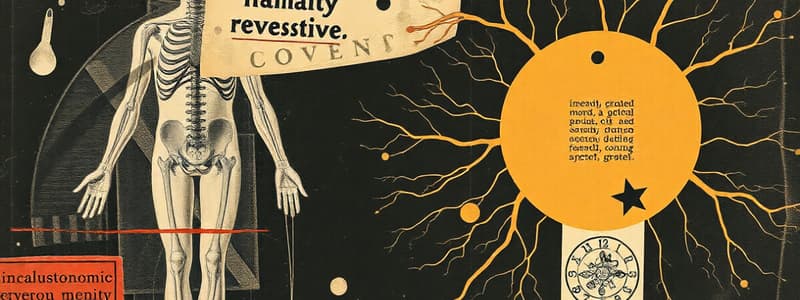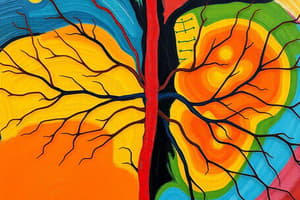Podcast
Questions and Answers
What is the primary effect of sympathetic nerves when body temperature rises?
What is the primary effect of sympathetic nerves when body temperature rises?
- Decrease in metabolic rate
- Dilation of cutaneous blood vessels (correct)
- Constriction of blood vessels
- Inhibition of sweat glands
What mechanism is stimulated by the sympathetic division to help raise blood pressure?
What mechanism is stimulated by the sympathetic division to help raise blood pressure?
- Vasodilation of blood vessels
- Increase in heart rate
- Renin release from kidneys (correct)
- Decreased blood glucose levels
What happens to blood glucose levels during the fight or flight response?
What happens to blood glucose levels during the fight or flight response?
- They remain unchanged
- They are regulated by parasympathetic fibers
- They decrease to conserve energy
- They increase due to glycogen breakdown (correct)
Which drug acts as a nicotinic cholinergic receptor antagonist?
Which drug acts as a nicotinic cholinergic receptor antagonist?
Which type of autonomic receptor do epinephrine and norepinephrine primarily bind to?
Which type of autonomic receptor do epinephrine and norepinephrine primarily bind to?
What is a significant role of the sympathetic division?
What is a significant role of the sympathetic division?
How do the sympathetic and parasympathetic divisions generally operate?
How do the sympathetic and parasympathetic divisions generally operate?
What is the primary function of drugs like scopolamine in relation to the ANS?
What is the primary function of drugs like scopolamine in relation to the ANS?
What is the primary difference in the neuron structure between the autonomic nervous system and the somatic nervous system?
What is the primary difference in the neuron structure between the autonomic nervous system and the somatic nervous system?
Which neurotransmitter is predominantly released by the postganglionic fibers of the sympathetic division?
Which neurotransmitter is predominantly released by the postganglionic fibers of the sympathetic division?
What effect does the sympathetic division typically have on digestion?
What effect does the sympathetic division typically have on digestion?
Which of the following receptors are exclusively excitatory?
Which of the following receptors are exclusively excitatory?
What is a characteristic of the parasympathetic division's preganglionic fibers?
What is a characteristic of the parasympathetic division's preganglionic fibers?
Which physiological response is primarily associated with the sympathetic nervous system?
Which physiological response is primarily associated with the sympathetic nervous system?
The effect of acetylcholine on the heart is primarily to:
The effect of acetylcholine on the heart is primarily to:
Which of the following is a function of the autonomic nervous system?
Which of the following is a function of the autonomic nervous system?
Which division of the autonomic nervous system is responsible for the 'rest and digest' response?
Which division of the autonomic nervous system is responsible for the 'rest and digest' response?
In what situation do the sympathetic and parasympathetic divisions work cooperatively?
In what situation do the sympathetic and parasympathetic divisions work cooperatively?
Flashcards
Sympathetic Nerve Response to Heat
Sympathetic Nerve Response to Heat
When body temperature rises, the sympathetic nervous system activates to cool the body by dilating blood vessels in the skin and activating sweat glands.
Renin Release by Sympathetic Division
Renin Release by Sympathetic Division
The sympathetic nervous system stimulates the release of renin from the kidneys, which helps increase blood pressure.
Sympathetic Impact on Metabolism
Sympathetic Impact on Metabolism
The sympathetic nervous system boosts metabolism during fight or flight by increasing cellular energy use, breaking down glycogen for glucose, and burning fat for energy.
Anesthetic Effect on Autonomic System
Anesthetic Effect on Autonomic System
Signup and view all the flashcards
Scopolamine and Muscarinic Receptors
Scopolamine and Muscarinic Receptors
Signup and view all the flashcards
Autonomic Nervous System's Role
Autonomic Nervous System's Role
Signup and view all the flashcards
Sympathetic vs. Parasympathetic Systems
Sympathetic vs. Parasympathetic Systems
Signup and view all the flashcards
Unique Sympathetic Functions
Unique Sympathetic Functions
Signup and view all the flashcards
What is the Autonomic Nervous System?
What is the Autonomic Nervous System?
Signup and view all the flashcards
What are the two branches of the Autonomic Nervous System?
What are the two branches of the Autonomic Nervous System?
Signup and view all the flashcards
How does the Sympathetic division affect the body?
How does the Sympathetic division affect the body?
Signup and view all the flashcards
How does the Parasympathetic division affect the body?
How does the Parasympathetic division affect the body?
Signup and view all the flashcards
What are Cholinergic receptors?
What are Cholinergic receptors?
Signup and view all the flashcards
What are Andrenergic receptors?
What are Andrenergic receptors?
Signup and view all the flashcards
What is the difference between Nicotinic and Muscarinic receptors?
What is the difference between Nicotinic and Muscarinic receptors?
Signup and view all the flashcards
How do the sympathetic and parasympathetic divisions interact?
How do the sympathetic and parasympathetic divisions interact?
Signup and view all the flashcards
What is the unique role of the Sympathetic division?
What is the unique role of the Sympathetic division?
Signup and view all the flashcards
What is a sympathetic ganglion?
What is a sympathetic ganglion?
Signup and view all the flashcards
Study Notes
Autonomic Nervous System
- The autonomic nervous system (ANS) regulates internal body functions unconsciously, adjusting to meet needs like fight-or-flight or rest-and-digest.
- The ANS is typically divided into two parts that oppose one another: sympathetic and parasympathetic.
- Sometimes they work together to balance bodily functions.
- The sympathetic nervous system (SNS) prepares the body for action ("fight or flight").
- The parasympathetic nervous system (PNS) calms the body and helps with "rest and digest".
Neuron Chain
- The autonomic nervous system uses a two-neuron chain.
- The first neuron (preganglionic) has its cell body in the central nervous system (CNS).
- The preganglionic axon synapses with the second neuron (postganglionic) in an autonomic ganglion.
- The postganglionic axon synapses with the target organ.
Somatic Nervous System
- The somatic nervous system operates consciously by directly innervating skeletal muscle.
- It uses single neurons extending from the CNS to the muscle.
- It primarily uses acetylcholine (ACh).
Neurotransmitters
- Acetylcholine (ACh): a neurotransmitter used by both the parasympathetic and somatic systems.
- Norepinephrine (NE): a neurotransmitter used by the sympathetic system; effects depend on receptor type.
- Epinephrine (adrenaline): a neurotransmitter used by the sympathetic system; effects depend on receptor type.
Sympathetic Nervous System (Fight-or-Flight)
- Originates from thoracic and lumbar spinal cord.
- Short preganglionic neurons, long postganglionic neurons.
- Ganglia near spinal cord.
- Increases heart rate, blood pressure, respiration, and other functions associated with alertness and energy expenditure.
- Decreases digestion.
- Dilates pupils (mydriasis)
Parasympathetic Nervous System (Rest-and-Digest)
- Originates from the brain and sacral spinal cord.
- Long preganglionic neurons, short postganglionic neurons.
- Ganglia near effector organ.
- Decreases heart rate, blood pressure, respiration.
- Increases digestion.
- Constricts pupils (miosis).
Receptor Types
- Cholinergic receptors receive acetylcholine (ACh).
- Nicotinic receptors: always excitatory
- Muscarinic receptors: can be excitatory or inhibitory
- Adrenergic receptors bind norepinephrine (NE) and epinephrine (E).
- Alpha receptors, Beta receptors: effects vary.
Drugs and the ANS
- Drugs can alter ANS function for various needs (e.g., anesthesia, treating asthma).
- Drugs can be agonists (mimicking the effect of a neurotransmitter) or antagonists (blocking the receptor from engaging with a neurotransmitter).
Regulation/Control
- The autonomic nervous system regulates body temperature, blood pressure, heart rate, etc.
- It helps maintain homeostasis; a dynamic balance.
- Sympathetic and parasympathetic activities work together or oppose one another depending on the need.
Studying That Suits You
Use AI to generate personalized quizzes and flashcards to suit your learning preferences.




